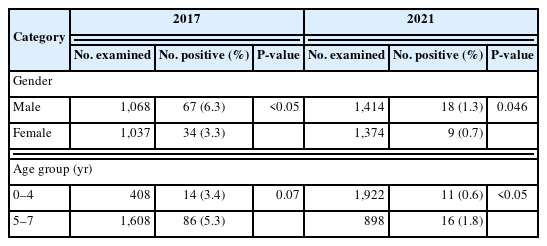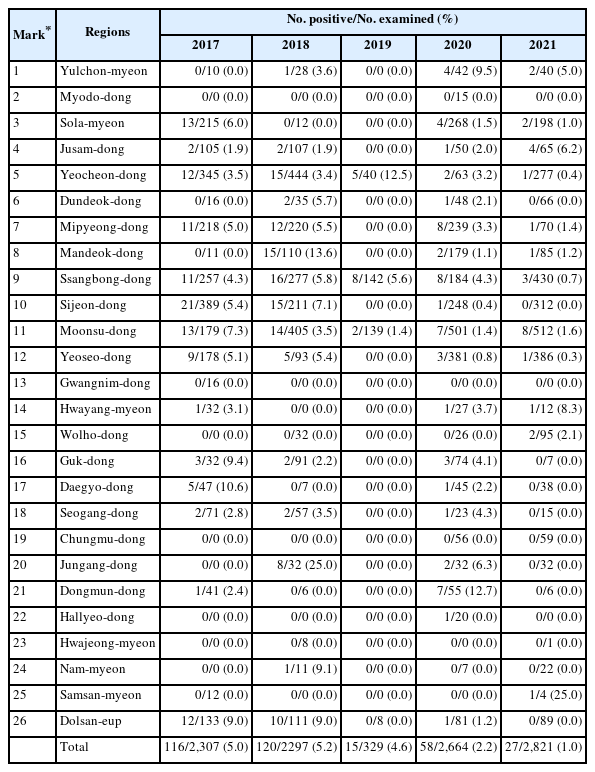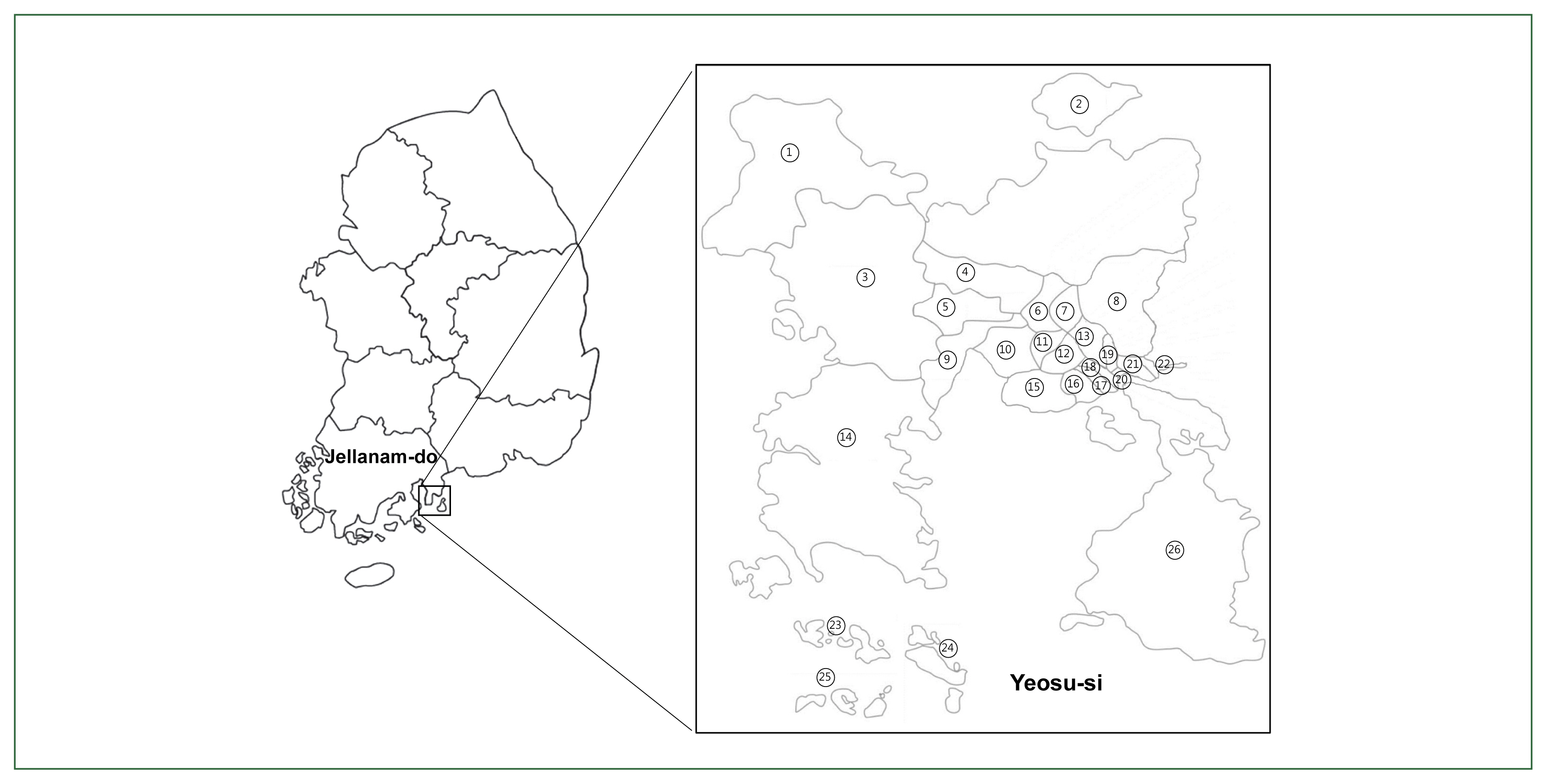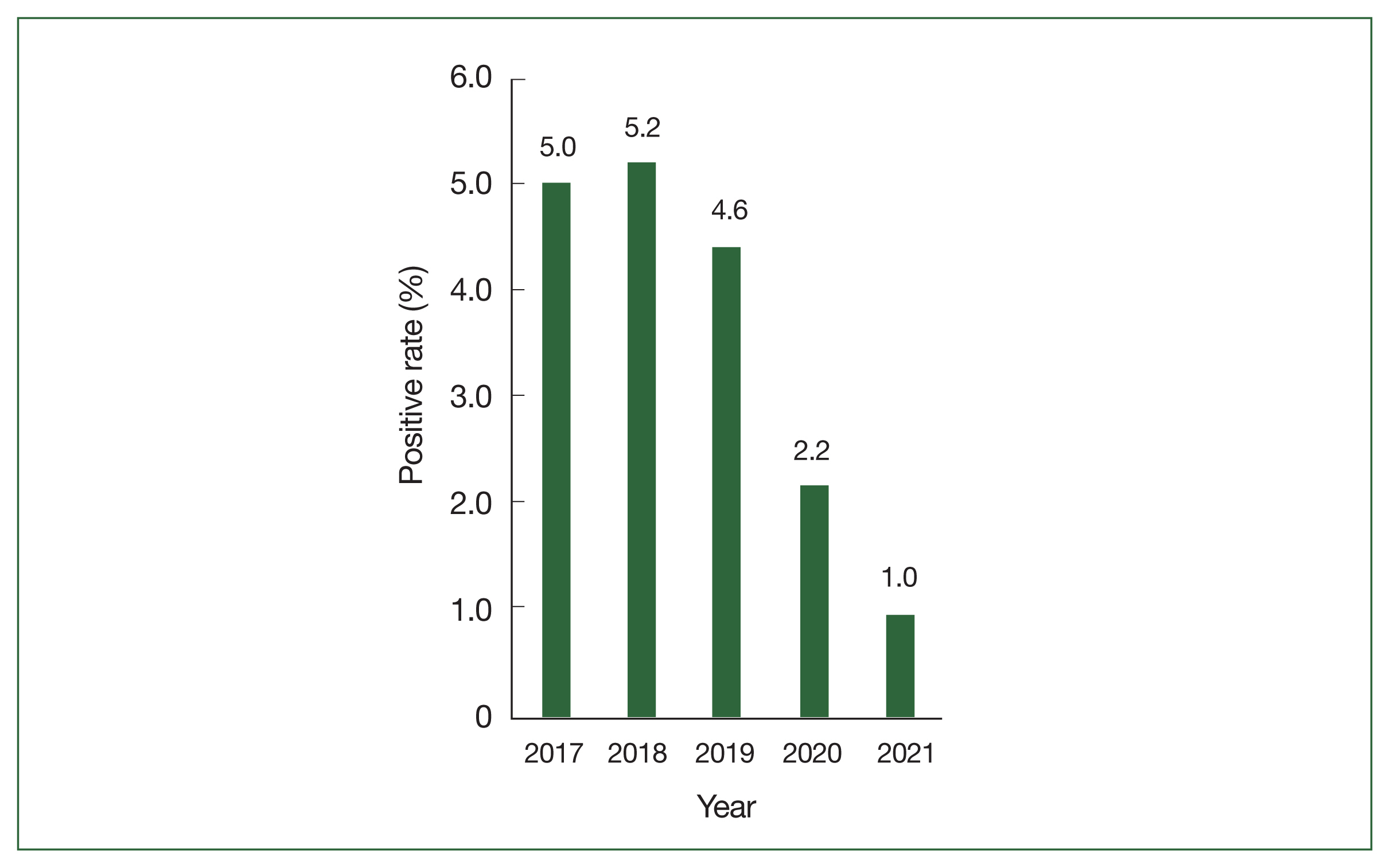Positive rates for Enterobius vermicularis eggs among preschool children in Yeosu-si, Jeollanam-do, Korea (2017–2021)
Article information
Abstract
This study aimed to evaluate the positive rates for Enterobius vermicularis eggs among preschool children in Yeosu-si, Jeollanam-do, the Republic of Korea (Korea) over a period of 5 years (2017–2021). Perianal swab samples, obtained using cellotape, from 10,392 preschool children in 26 districts were examined microscopically for E. vermicularis eggs. The test results were notified through the local health center, and the families of children who tested positive were advised to provide them anthelmintics treatment. The annual positive rates were 5.0%, 5.2%, 4.4%, 2.2%, and 1.0% in 2017, 2018, 2019, 2020, and 2021, respectively. The overall positive rate was higher in boys than in girls (P<0.05), and children aged 5–7 years were at a higher risk of being infected than those aged 0–4 years (P<0.05). Although the rates of infection by E. vermicularis in the survey area, Yeosu-si, were still in the 1% range, the results of this study suggest that they can be significantly reduced through continuous intervention centered around the test–treatment strategy.
Enterobiasis, an infection caused by the human nematode parasite Enterobius vermicularis (pinworm), is commonly observed in children from developed and developing countries. It typically spreads through direct transmission from an infected individual to an uninfected one, but it can also be contracted through actions, such as sucking on toys, pencil biting, and playing in areas contaminated with pinworm eggs [1]. Moreover, it is commonly observed in overcrowded areas, such as preschools [2], and its estimated global prevalence in children is 5.1–22.4% [3–6]. In 2000, Park et al. [7] reported that the positive rate of E. vermicularis infection among children in the western and southern offshore islands of the Republic of Korea (Korea) was 18.5%, whereas other studies reported rates ranging from 3.5% to 10.0% in other parts of Korea, such as Paju-si (3.5%), Inje-gun (4.6%), Chuncheon-si (5.7%) [8], Gimhae-si (10.5%) [9], and Muan-gun (4.0%) [10]. Moreover, the prevalence rates of infection in Seoul and other large cities have been reported to range between 0.6% and 3.9% during 2008–2019 [11]. However, to the best of our knowledge, no consecutive surveys of the rates of pinworm infections among preschool children in the same local region have been conducted to date. Therefore, this study aimed to determine the incidence of E. vermicularis infection among preschool children in Yeosu-si.
The need for ethical approval was waived as this study was conducted to evaluate public welfare through a fact-finding survey (Infectious Disease Control and Prevention Act, Article 17). In total, 10,392 children from 26 districts (including 20 from dong, 1 from eup, and 5 from myeon) in Yeosu-si were examined for the presence of E. vermicularis eggs using the cello tape perianal swab method (Fig. 1). Parents of these children were instructed to press the sticky side of a cellophane tape on the perianal area of the child immediately after they woke up, and all collected samples were collected by the preschool teachers and transported to the Division of Vectors and Parasitic Diseases, Korea Disease Control and Prevention Agency. Subsequently, the samples were assessed by qualified technicians using light microscopy, with the presence of eggs being confirmed at low magnification (×100) and identification of the E. vermicularis eggs being carried out at high magnification (×400). Notably, the pinworm egg resembles a persimmon seed in shape, with length and width ranging from 50 to 60 μm and 20 to 30 μm, respectively.
Data analysis included comparison of categorical variables using a chi-square test, and the incidence trends of E. vermicularis infection were examined in terms of age and sex. All statistical analyses were performed using SPSS, v18.0 (IBM, Chicago, IL, USA), and the level of statistical significance was set at P<0.05 with a 95% confidence interval.
Overall, >2,000 samples were examined every year (except 2019), and the results revealed that the rates of E. vermicularis infection in Yeosu-si, Jeollanam-do, gradually decreased between 2017 and 2021 (Fig. 2; 5.0% (116/2,307 children) in 2017; 5.2% (120/2,297) in 2018; 4.4% (15/329) in 2019; 2.2% (58/2,664) in 2020; and 1.0% (27/2,821) in 2021). Notably, the rate of E. vermicularis infection was statistically significantly declined by 2021 (P<0.05).
This study was conducted in 26 of 27 districts in Yeosu-si (excluding Samil-dong). In 2017, the rate of E. vermicularis infection was highest in Daegyo-dong (10.6%), followed by Guk-dong (9.4%), Dolsan-eup (9.0%), and the other regions (<9%). In 2021, the rates of infections in Hwayang-myeon (8.3%) and Samsan-myeon (25.0%) were high, although the number of examinees (or subjects) was small (Table 1). In districts with high infection rates, including Daegyo-dong, Guk-dong, Dolsan-eup, Moonsu-dong, and Sola-myeon, the rates of E. vermicularis infections decreased from 6.0 to 10.6% in 2017 and from 6.0 to 1.6% in 2021. This reduction in infection rates could be attributed to the continuous management and treatment of infected children and their family members, which is considered an effective strategy for controlling E. vermicularis infection among preschool children.
Examination of the risk of E. vermicularis infection by sex revealed that males exhibited 2 times higher risk (6.3%) than females (3.3%) in 2017. Similar results were observed in 2021, despite the decrease in overall rates of infection (P<0.05; Table 2).

Comparison of the egg positive rates of Enterobius vermicularis by the gender and age-group in 2017 and 2021
The study population was classified into age groups of 0–4 and 5–7 years to account for differences in preschool programs (i.e., children aged <4 years: nap time and fewer educational activities; children aged >5 years: no nap time and more opportunities to engage in outdoor activities with children from other classes). The children in the 5–7 year age group exhibited significantly higher infection rates than those in the 0–4 year age group (P<0.05). Moreover, in 2017, children in the 5–7 year age group exhibited a 1.5 times higher probability of being infected with E. vermicularis than those in the 0–4 year age group, and this probability increased to 3 times in 2021 (P<0.05; Table 2). This finding is consistent with previous studies, which have also observed a higher risk of pinworm infection in children in the 5–7 year age group than in younger children, possibly due to more frequent exposure to contaminated environments [12–15].
Hong et al. [10] reported that the E. vermicularis infection rate in Jeollanam-do was 1.5% in 2019. However, the infection rate in Yeosu-si at the beginning of this survey was 3 times higher (4.6%) than that observed in Jeollanam-do in 2019, indicating that it can be considered a high-risk area for pinworm infections requiring the adoption of continuous management strategies.
In conclusion, E. vermicularis infections are still widely prevalent among preschool children in Yeosu-si, and continuous examination and treatment of infected children and their families is required to decrease incidence rates.
Acknowledgments
We thank the person in charge of the Yeosu Health Center for participating in sample collection for this study. This work was supported by a grant (6331-311-210-13, 2021) from the Korea Disease Control and Prevention Agency (KDCA), Republic of Korea.
Notes
Author contributions
Data curation: Ju JW
Investigation: Shin HE, Back SO, Lee YJ, Park CS
Supervision: Lee HI
Writing – original draft: Lee MR
The authors declare no conflict of interest related to this study.



